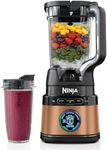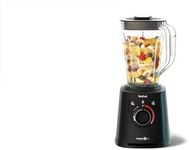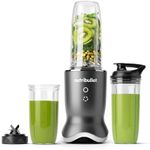Buying Guide for the Best Blenders
Choosing the right blender can significantly enhance your kitchen experience, whether you're making smoothies, soups, or sauces. The key is to understand your needs and match them with the blender's features. Consider what you'll be blending most often, how frequently you'll use the blender, and where you'll store it. This will help you determine the right balance of power, capacity, and additional features that suit your lifestyle.Power (Wattage)The power of a blender, measured in watts, determines how effectively it can blend tough ingredients. Higher wattage blenders (around 1000 watts or more) are ideal for crushing ice and blending hard vegetables, while lower wattage blenders (around 300-600 watts) are suitable for softer ingredients like fruits and liquids. If you plan to make smoothies with ice or blend fibrous vegetables, opt for a higher wattage. For simple tasks like making milkshakes or pureeing soft fruits, a lower wattage will suffice.
CapacityBlender capacity refers to the volume the jar can hold, usually measured in liters or cups. Larger capacities (around 2 liters or more) are great for families or those who like to prepare large batches, while smaller capacities (around 1 liter) are suitable for individuals or small households. Consider how much you typically prepare at once; if you often make single servings, a smaller capacity will be more efficient and easier to clean.
Material of JarBlender jars are typically made from glass or plastic. Glass jars are heavier and more durable, often preferred for their resistance to staining and odor retention. Plastic jars are lighter and less prone to breaking, making them a good choice for households with children. If you prioritize durability and don't mind the extra weight, go for glass. If you need something lightweight and shatterproof, plastic is the way to go.
Speed SettingsSpeed settings allow you to control the texture and consistency of your blends. Basic blenders may have 2-3 speed settings, while more advanced models can have up to 10 or more. More speed options provide greater control over the blending process, which is useful for achieving specific textures. If you only need a blender for simple tasks, a few speed settings will suffice. For more versatility, especially if you plan to experiment with different recipes, look for a blender with multiple speed options.
Blade DesignThe design and material of the blades affect how well a blender can process different ingredients. Stainless steel blades are common due to their durability and resistance to rust. Some blenders have specially designed blades for specific tasks, like crushing ice or making smoothies. Consider what you'll be blending most often; if you need a versatile blender, look for one with multi-purpose blades. If you have specific needs, such as ice crushing, ensure the blades are designed for that purpose.
Ease of CleaningEase of cleaning is an important factor, especially if you plan to use your blender frequently. Some blenders have dishwasher-safe parts, while others require hand washing. Blenders with detachable blades are generally easier to clean. If convenience is a priority, look for models with easy-to-clean features, such as removable blades and dishwasher-safe components. If you don't mind a bit of extra effort, you can opt for models that require manual cleaning.

















